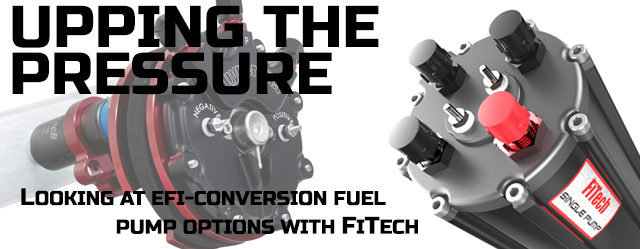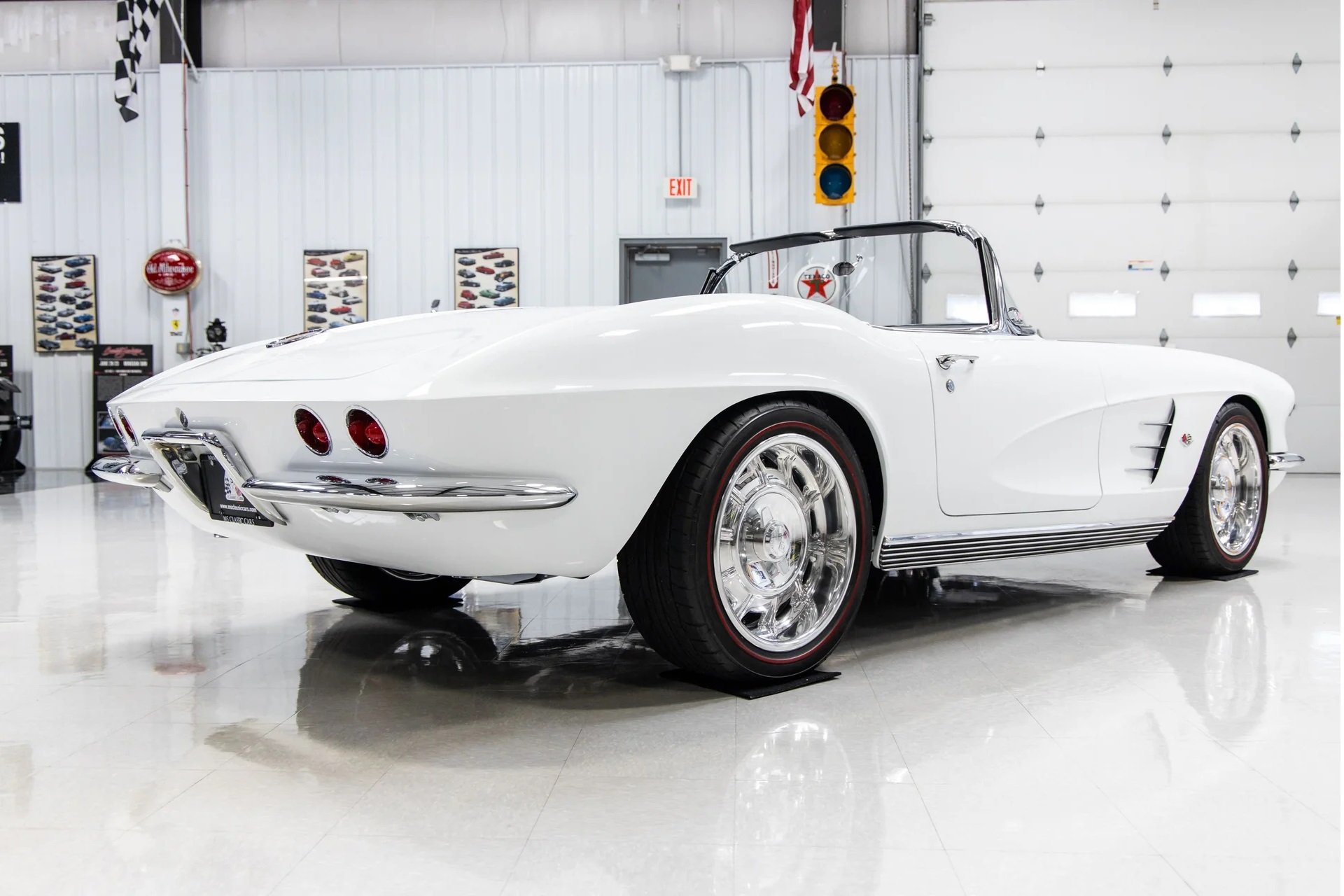When you are building your car from scratch or converting your car from a carbureted setup to an electronic fuel injection setup, plumbing your fuel system can be one of the most intimidating parts of the journey. There are a lot of aspects of fuel delivery that need to be considered, all of which will affect which path you choose.
Fortunately, the folks at FiTech have a number of options from basic to completely trick, to keep your injectors supplied with enough fuel to support almost any of your horsepower endeavors. Designed and developed using OEM-level engineering and components, FiTech aims to produce the most affordable electronic fuel injection systems on the market.
As such, they have not only developed the hardware and software for EFI systems to support up to 1200-horsepower, but also the supporting components – like fuel pumps. We’re going to walk you through FiTech’s line of fuel pump products to help you decide which might be right for you and your particular muscle car application.
Inline Frame Mount
The first kit we’re going to talk about from FiTech is probably the simplest and most traditional fuel pump kit they offer, the Inline Frame Mount kit. “The inline kit is one of the most versatile we offer,” says FiTech’s Ken Farrell. “It comes with all the parts you need to put it in, and is what we call a standalone kit, as it will work with a FiTech EFI system, or any EFI system.”
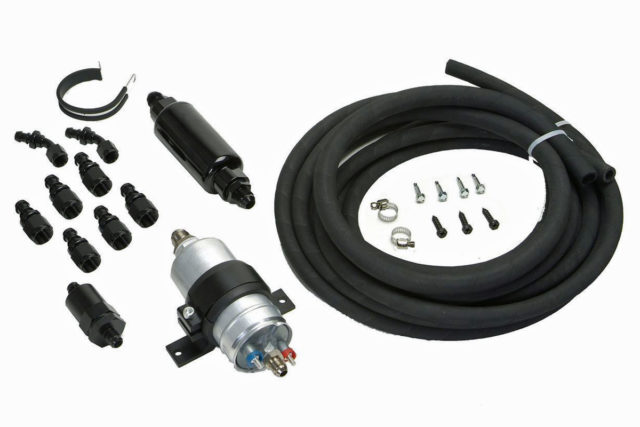
The frame-mount inline pump kit comes with the fuel pump, billet pre- and post-filters, push-lock fittings, and both -6 feed and -8 return fuel line.
As the name implies, this kit contains an externally-mounted 255 liter-per-hour pump, which will support up to 600 naturally-aspirated horsepower. While probably one of the simpler kits to mount, plumb, and wire, you will need to plumb a fuel return line when using the inline frame mount kit. However, that shouldn’t prove difficult, as FiTech includes 20 feet of -6 fuel hose and 5 feet of -8 fuel hose in the kit. It even comes with push-lock style hose ends, and mounting brackets.
Also included in the kit are FiTech’s billet pre- and post-pump filters. The 100-micron pre-filter has ORB-10 threads and mounts between the tank and the pump, while the 30-micron post-pump filter has -06 AN threads and mounts between the pump and injectors. Both filters have been designed specifically for modern EFI systems.
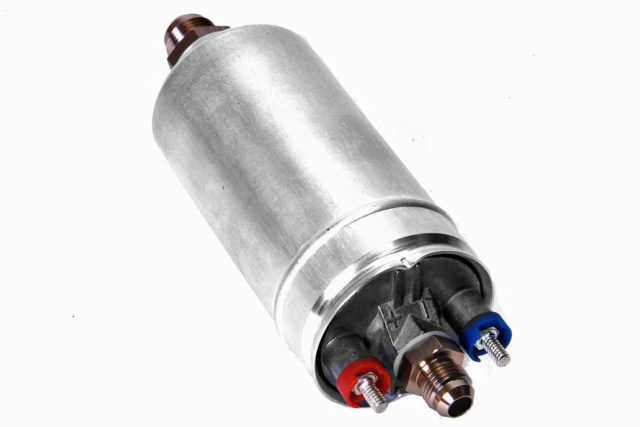
The 255 liter-per-hour external fuel pump included in the inline kit will move enough fuel for up to 600 naturally-aspirated horsepower.
While simple and versatile, there is a drawback to an external pump, and that is the noise. Since the pump isn’t submerged in fuel, or inside of another container, more of its operating noise escapes into the outside world. However, FiTech EFI systems incorporate voltage control, which only runs the pump as hard as is needed. This is to help reduce noise in low-load situations.
Fuel Command Center
This is definitely the easiest way to convert to high-pressure for an EFI system. – Ken Farrell, FiTech
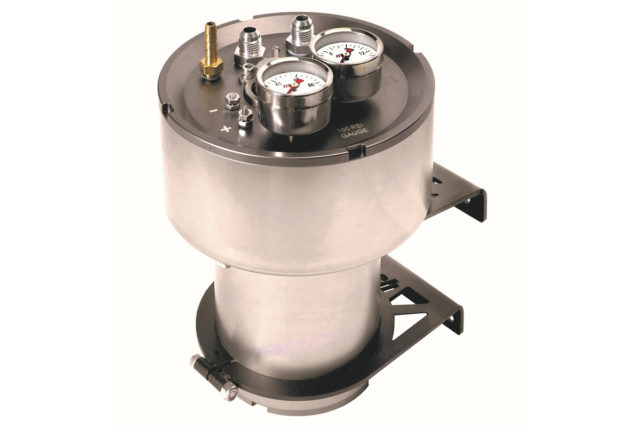
The Fuel Control Center uses the Yeti-cup-shaped fuel reservoir to hold the fuel provided by your stock low-pressure pump to feed the internal high-pressure pump.
“Coming from a carbureted system, you either have a pump on your engine or an electric pump, but both are putting out at low pressure. Rather than replacing that entire setup, you can just pull the feed line off the carburetor, and put it into the Fuel Command Center,” Farrell says. “This is definitely the easiest way to convert to high-pressure for an EFI system.”
The 340 liter-per-hour high-pressure pump is capable of supporting 800 horsepower, and is fed from the integrated fuel sump, which the original carbureted fuel system keeps full. It includes a float, which automatically shuts off the incoming flow of fuel to the Fuel Command Center’s sump tank when the correct fuel level is reached. At that time, the stock pump is then deadheaded the same as a traditional fuel pressure regulator would.
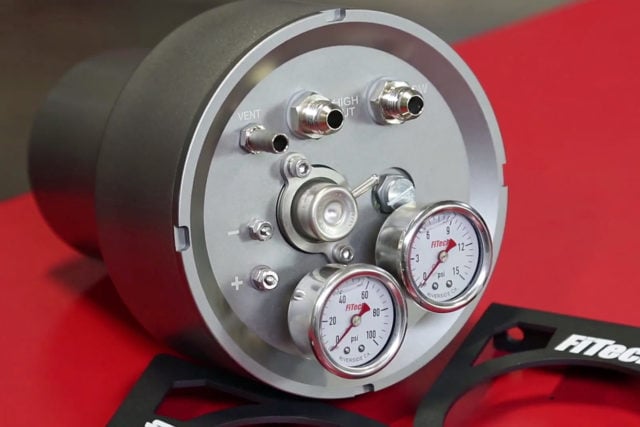
As you can see from the two gauges, you can monitor both the input and output pressures. You can adjust the latter via the built in fuel pressure regulator.
The Fuel Command Center is a complete assembly, including the pump, regulator, and pressure gauges all incorporated into one unit. Ideally, it would be mounted under the hood near the engine to limit the amount of new plumbing required. It comes with enough fuel hose and fittings to plumb the Fuel Command Center into the EFI throttle body or fuel rails, and includes a billet fuel filter to be placed between the pump and engine.
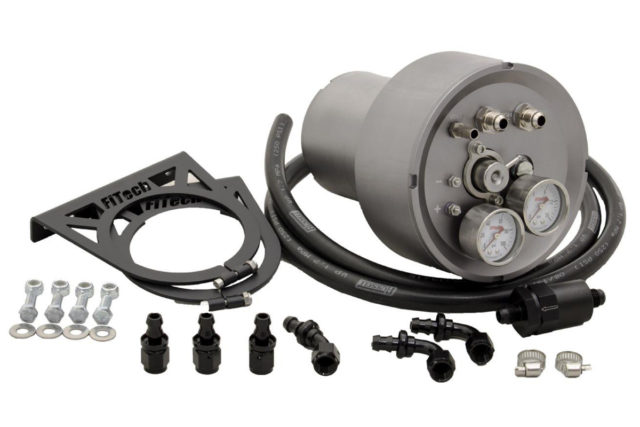
As a kit, the Fuel Command Center comes with everything needed to complete its extremely simple installation.
“You will need to run a vent line back to your stock tank. A lot of tanks have a vent line port already built into them, and if it doesn’t, you can just run the vent line to your filler neck. It’s not terribly hard to do, but it has to be done,” says Farrell. “The Fuel Command Center is also significantly quieter than the external pump. It’s almost silent.”
HyperFuel G-Surge Tank
FiTech’s next option is similar to the Fuel Command Center, in that it is a supplemental sump and additional pump. But unlike the Fuel Command Center, the G-Surge Tank is more complex, and aimed more specifically at high-performance applications that will see hard acceleration, deceleration, and cornering forces.
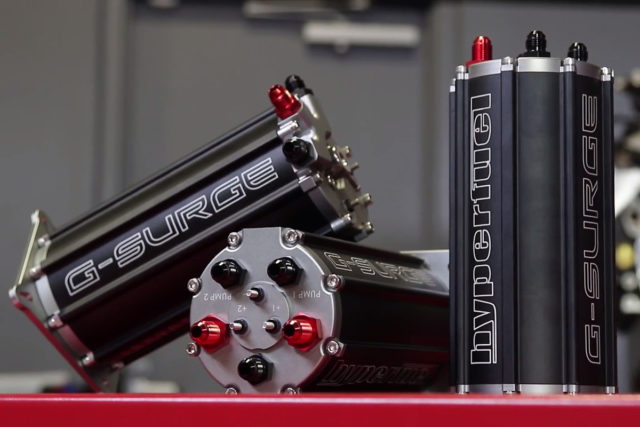
Available in both single and dual-pump models, the FiTech Hyperfuel G-Surge can support up to 1,600 horsepower, and prevent fuel starvation under heavy G-forces.
Unlike the Fuel Command Center, the G-Surge tank has a return line to your fuel tank, and is constantly moving fuel with your low-pressure fuel system, and is never deadheaded. This, in turn, keeps your pump cooler and increases its lifespan. Its compact size means that it can be mounted in a variety of locations, and the G-Surge’s tank design allows a mounting angle of up to 45-degrees, while ensuring the internal 340 liter-per-hour high-pressure pump is never starved for fuel, even if your stock tank is poorly baffled.
“You can mount the G-Surge anywhere,” says Farrell. “We don’t supply all of the hose and fittings that we do with other kits, because it’s so versatile, we really have no idea where it will end up mounted, or what application it will be used.” In the single-pump version, up to 800 horsepower can be supported, in both internally- and externally-regulated variants, while the dual-pump version is capable of supporting a whopping 1,600 horsepower. That makes it ideal for forced-induction applications, as well as use in all-forms of motorsport.
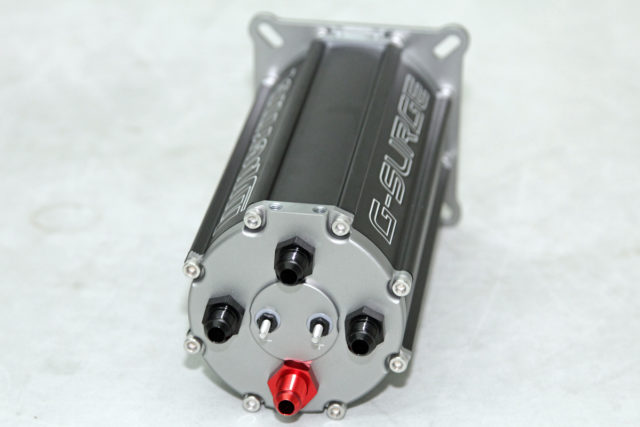
As you can see by the four ports on this single-pump model, both the low-pressure and high-pressure systems are return-style. That keeps fuel constantly moving, and all the pumps running cooler. There is an option for a built-in regulator on the single-pump model, but not on the dual-pump version.
So, while the plumbing of the G-Surge is the most complicated of the supplemental pumps, it is also the highest-performing supplemental option. In addition to the massive amounts of horsepower that it can support, and the ability to cure fuel starvation issues, the G-Surge Tank also runs cooler and quieter than other options, and keeps your factory fuel pump cooler, as well.
Hy-Fuel In-Tank Retrofit Kit
The final fuel pump kit that FiTech offers, is their Hy-Fuel in-tank retrofit kit. It is the most “traditional” modern EFI fuel pump kit, in that it puts the pump in the fuel tank, like OEMs today. The benefits of this type of kit are immediately obvious. It is completely submerged in fuel, at the rear of the car, and it is the quietest of any of FiTech’s offerings. That fuel submersion will also keep the pump as cool as is physically possible.
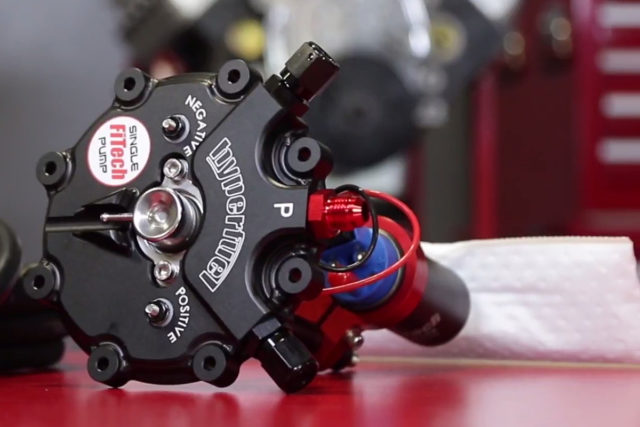
The in-tank retrofit kit features a thin hat to make sure that there is no interference with tight-fitting tanks. The dual return ports allow flexibility in fuel line routing options.
Less than 1-inch tall, the Hy-Fuel’s “hat” fits on tanks that have even the tightest of clearances. The adjustable mounting bar means that it will operate in tanks from 6 to 14 inches deep, with an extended rod available for deeper tanks. The mounting rings are made from precision-machined, billet aluminum, and screwed together for insanely-secure mounting. The integrated O-ring seal not only provides a leak-free product, but also allows for easy removal and reinstallation for servicing.
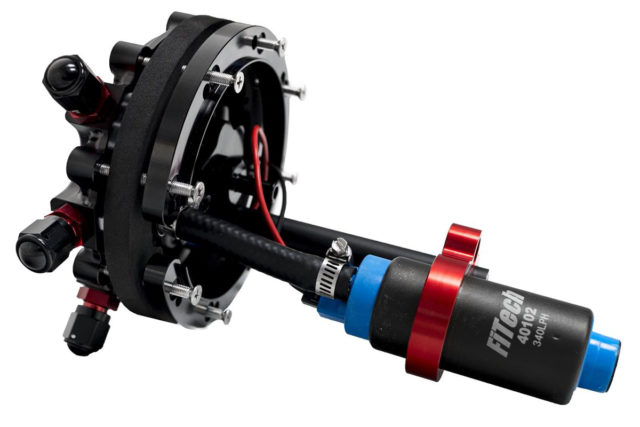
Out of the box, the in-tank portion of the assembly will work with tanks from six to fourteen inches deep. For deeper tanks, there are longer mounting rods available.
The kit features a 340 liter-per-hour pump to support up to 800 horsepower – which is E85-compatible – and comes with a built-in fuel pressure regulator, or optional block-off plate. “You don’t have to run the included regulator – you can block it off. We made the built-in regulator externally accessible, so that you can run a boost or vacuum-reference line to it,” says Farrell. By running the built-in regulator, the fuel system can be utilized as a returnless-style system, or, with the use of the block-off plate and an external regulator, more like traditional return-style system.
The pump also comes with an innovative, 35-square-inch filter sock that not only protects the pump, but increases pickup area. The Hy-Fuel In-Tank kit is also available in a dual-pump variant, which, like the G-Surge, is only available in an unregulated version, but will support 1,600 horsepower.
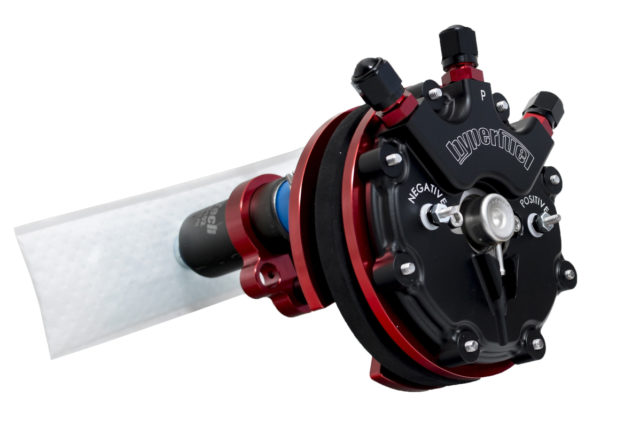
The 35-square-inch filter sock not only acts as a pre-filter, but also aids in picking up fuel. “As long as the sock is touching fuel, the pump will be able to pick it up,” Farrell says.
Regardless of your particular setup, or how in-depth of an installation you are comfortable with, FiTech has a fuel delivery option that will not only help you easily convert from a carburetor to EFI, but will do it quietly and effectively. Whether your muscle car is making 150 or 1,500 horsepower, FiTech has your fuel delivery needs covered.



